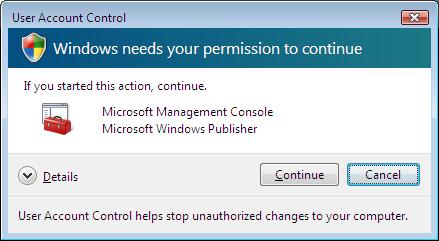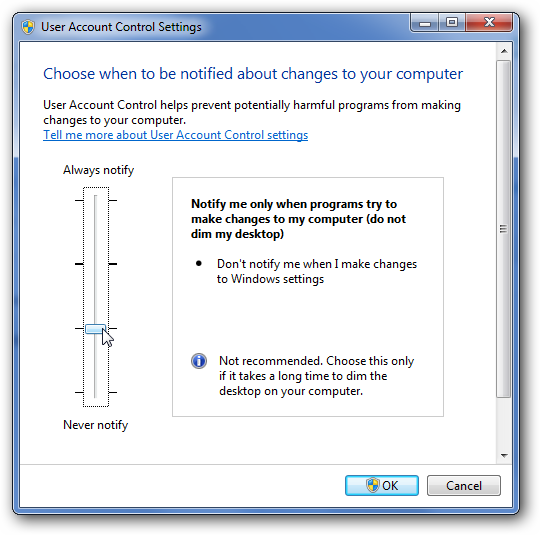-
-
products
-
resources
-
support
-
company
-
Configuring User Account Control in Windows Vista & Windows 7
By Steve Horton August 02, 2013security, UAC, user account control, users, Windows 7, windows vistaNo CommentsIf multiple individuals use a single computer, it is a good idea to set up different accounts for each individual. This way, it is possible to block certain programs and content to children, grant access to other titles to adults and to monitor what each individual is doing on the computer. User Account Control allows you to control the security level for each user on the system. Both Windows Vista and Windows 7 offer options for setting up User Account Control, although the method of reaching these features is a bit different. Thankfully, once you have altered User Account Control once or twice, you shouldn’t have a problem doing it again in the future.

If you make changes to your Windows system, you’ll often see this User Account Control popup.Windows Vista
Windows Vista’s User Account Control is specifically designed to prevent any sort of unauthorized changes and alterations to your computer. If you have children, you’ve probably logged on, only to find the entire background changed to some outlandish image and all the font sizes enlarged to 10 times what the typical font is. With User Account Control set up, you’ll never have to worry about it again. When performing this task, make sure to sign in as the administrator of the computer. If you don’t, you probably won’t be able to change these settings.
To configure and reach the User Account Control in Windows Vista you need to click Start, then click Control Panel. Then, click User Accounts and Family Safety. Under the new window, click User Accounts. When you are in the new window, click Turn User Account Control On. You might be required to type in the admin password in order to confirm the change to the system. After entering the password, select Use User Account Control (UAC) to help protect your computer to turn on UAC, and click OK to confirm.
Windows 7
In order to change the user account control in Windows 7 you need to start by clicking Start and then Control Panel. Click User Accounts, then Change User Account Control Settings. If you want to turn off the UAC, you need to move the slider to the Never Notify position and then click OK. You might be asked to enter in the admin password, in which case, just type the information in and click OK again. If you want to turn the UAC feature on, you need to move the slider to the preferred location for the particular user, then click OK. You again might be asked to type in the admin password in order to confirm the changes.

The slider allows you to adjust User Account Control security levels.User Account Control Settings
There are four basic settings when using the User Account Control Settings slider. The higher the slider bar is placed, the more notifications you receive when someone attempts to make changes to the computer system. The lower the slider goes, the fewer notifications you are going to receive.
Top Setting
When the slider is all the way at the top, you are going to receive a notification when anything changes on the computer. This ranges from a change in the display, to the installation of a new program, or the removal of a program. Basically, whenever anything changes you are going to receive a notification. If you leave your computer logged in under your own account, it is a good idea to keep the slider at the top option, just in case someone decides to alter the settings when you are not on the computer.
Second Setting
The second setting is the Default setting. This notifies you only when a program attempts to make changes on the computer but it doesn’t notify you when you make changes to Windows settings. This is the default setting, as it reduces the number of notifications you receive due to changes you make, as the computer assumes you are making the changes yourself anyway, so you don’t need to know.
Third Setting
The next setting is the first from the bottom. This reduces the number of notifications you receive, and only sends you notifications when drastic changes are made.
Bottom Setting
The last setting is the Never Notify option. The never notify option is going to prevent you from seeing any sort of notification when changes are made. This is helpful when you are on the computer on your own, and you don’t need to worry about other individuals changing the settings of your computer.
Was this post helpful?YesNoFree Driver Updates
Update your drivers in less than 2 minutes to enjoy better PC performance - Free.
Free Driver Updates
Update your drivers in less than 2 minutes to enjoy better
PC performance - Free.
Didn't find your answer?Ask a question to our community of experts from around the world and receive an answer in no time at all.most relevant recent articles Pin It on Pinterest